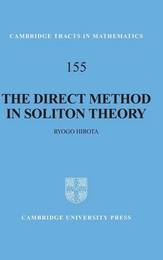
|
The Direct Method in Soliton Theory
Hardback
Main Details
| Title |
The Direct Method in Soliton Theory
|
| Authors and Contributors |
By (author) Ryogo Hirota
|
|
Edited and translated by Atsushi Nagai
|
|
Edited and translated by Jon Nimmo
|
|
Edited and translated by Claire Gilson
|
| Series | Cambridge Tracts in Mathematics |
|---|
| Physical Properties |
| Format:Hardback | | Pages:214 | | Dimensions(mm): Height 229,Width 152 |
|
| ISBN/Barcode |
9780521836609
|
| Classifications | Dewey:515.353 |
|---|
| Audience | | Professional & Vocational | |
|---|
|
Publishing Details |
| Publisher |
Cambridge University Press
|
| Imprint |
Cambridge University Press
|
| Publication Date |
22 July 2004 |
| Publication Country |
United Kingdom
|
Description
The bilinear, or Hirota's direct, method was invented in the early 1970s as an elementary means of constructing soliton solutions that avoided the use of the heavy machinery of the inverse scattering transform and was successfully used to construct the multisoliton solutions of many new equations. In the 1980s the deeper significance of the tools used in this method - Hirota derivatives and the bilinear form - came to be understood as a key ingredient in Sato's theory and the connections with affine Lie algebras. The main part of this book concerns the more modern version of the method in which solutions are expressed in the form of determinants and pfaffians. While maintaining the original philosophy of using relatively simple mathematics, it has, nevertheless, been influenced by the deeper understanding that came out of the work of the Kyoto school. The book will be essential for all those working in soliton theory.
Author Biography
fm.author_biographical_note1 fm.author_biographical_note2 fm.author_biographical_note3 fm.author_biographical_note4
Reviews'Overall, the book under review is a concise and essentially self-contained book, written by one of the leading researchers associated with the development of soliton theory ... provides an interesting insight into the development of a straight forward method for obtaining exact solutions for wide classes of nonlinear equations.' Peter Clarkson, University of Kent ' ... a nice example of a mathematical writing that can be read at nearly normal pace, which is extremely rare nowadays.' Zentralblatt MATH
|